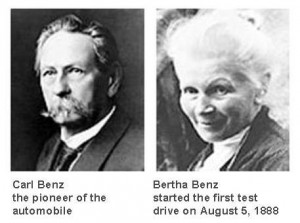
Mon, 2011-11-07 19:23 — Carl Benz Academy…
Carl Benz was born in 1844 in Karlsruhe, Baden, Germany, a son of an engine driver. Despite the limited means of his family, his mother insisted upon providing him with a good technical education. Being a diligent student, Benz passed the entrance exam to study mechanical engineering at the Karlsruhe Institute of Technology (KIT), formerly known as the Polytechnic College. At the tender age of fifteen he came under the instruction of Ferdinand Redtenbacher and graduated on July 9, 1864, with a degree in mechanical engineering. During his years at the university he had already started to envision concepts for a vehicle that would eventually become the horseless carriage.
In 1871, at the age of twenty-seven, Carl Benz joined a mechanical workshop in Mannheim, working together with his friend August Ritter. He first began his work on a two-stroke engine in the hopes of finding new sources of income and despite some early business misfortunes, successfully developed new types of engines and patented key engine components. These patents, among them the patent for the first internal combustion engine (approved in 1879), soon led to substantial revenue increases and helped to subsidize the workshop business.
Carl Benz’ true genius became obvious thanks to his successive inventions registered whilst designing what would become the production standard for his two-stroke engine. During this time he patented the speed regulation system, the ignition using sparks with a battery, the spark plug, the carburetor, the clutch, the gear shift, and the water radiator.
The success of the company gave Carl Benz the opportunity to indulge in his old passion of designing a horseless carriage. He finished his creation in 1885 and named it the Benz Patent Motorwagen. It was the first automobile entirely designed as such to generate its own power, which is why Carl Benz was granted his patent and is regarded as its inventor. The car was first driven in Mannheim in 1885.
In 1887, after years of testing and modifications, Benz created the first definitive commercial vehicle, the Model 3, an automobile with a four-stroke engine of his own design which was gasoline powered, with wooden wheels. This became the first production automobile. The model 3 was introduced at the 1889 World Fair in Paris and soon received recognition from around the world.
In the 1880’s, automobile owners faced considerable problems as gasoline was only available from pharmacies. The early 1888 version of the “Motorwagen” had to be pushed when driving up a steep hill. This limitation was rectified after Berta Benz made her famous trip, driving one of the vehicles a great distance. On returning, she suggested the addition of another gear to her husband. The popular story goes, that on the morning of August 5, 1888, Berta Benz borrowed this vehicle (without the knowledge of her husband), and embarked on a 106 km (fifty mile) trip from Mannheim to Pforzheim to visit her mother, taking her sons Eugene and Richard with her. In addition to having to scrounge for fuel at pharmacies on the way, she also overcame various technical difficulties and finally arrived at nightfall announcing the achievement to Carl Benz by telegram.
In 1896, Carl Benz was granted a patent for his design of the first ‘boxer engine’ with horizontally-opposed pistons, a design principle which still remains relevant for high-performance racing car engines such as those used by Porsche. The great demand for internal combustion engines increased the size of, and indeed, completely transformed the Benz & Cie. automobile company. By 1899 it had become the largest of its kind in the world, increasing employment from 50 (1890) to 430 (1899) workers and producing 572 automobiles per year.
After World War I, the years of Depression led to an economic crisis and it became desirable for Benz & Cie to pool its resources with another leading company in Stuttgart, Daimler Motors, founded by Gottlieb Daimler and his lifelong partner Wilhelm Maybach. In 1926 the two merged to become the Daimler-Benz company, later to be renamed as Daimler-Benz, which is now part of Daimler AG. Following the merger in 1926, all new automobiles were called Mercedes-Benz in honor of the most important model of DMG automobiles, the Mercedes 35hp.
The name ‘Mercedes’ derives from the ten year-old daughter of Emil Jellinek, the wealthy European entrepreneur who sat on the board of Daimler Motoren Gesellschaft (DMG) in the early 1900’s and who helped to improve the design of the DMG engines.
Carl Benz served as a member of the supervisory board of Daimler AG from 1926 until he passed away in 1929.
(Source: https://www.benz-academy.org/en/about/Carl_Benz)